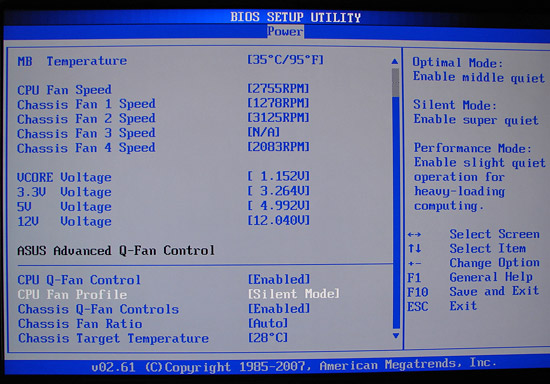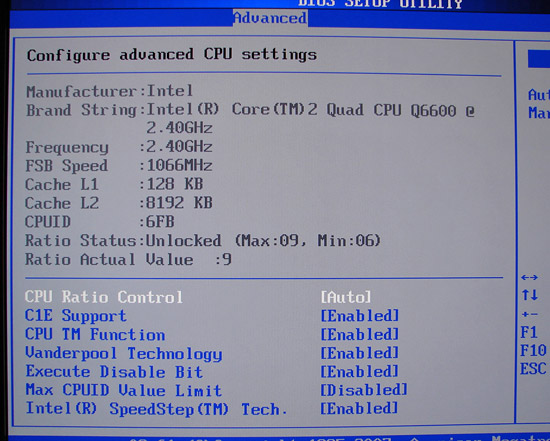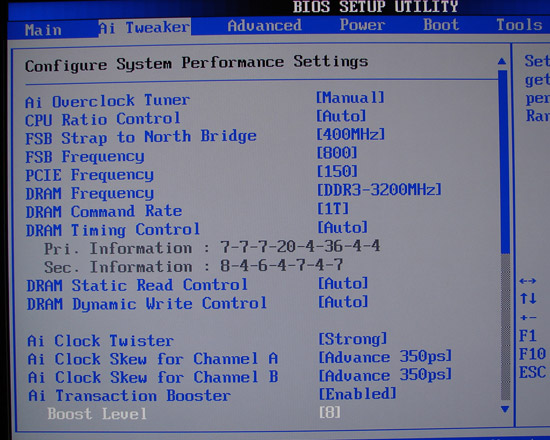ASUS P5E3 Deluxe: X38 and DDR3 arrives... almost
by Gary Key on September 18, 2007 4:00 AM EST- Posted in
- Motherboards
ASUS P5E3 Specifications and BIOS Overview
As mentioned, the P5E3 Deluxe board is designed for the general enthusiast with an emphasis on features designed for the home user, whether it is for gaming or home theater usage. ASUS provides two eSATA ports via the JMicron JMB363 chipset, IEEE-1394 support from Agere, excellent onboard audio support from the ADI 1988B, an 802.11n WiFi port, and dual Gigabit LAN capability. The board offers a very good mix of expansion slots, though utilizing a CrossFire setup will create the physical loss of a PCI-E x1 and PCI 2.2 slot. The third PCI-E x16 slot operates at x8 electrically and can be utilized for various PCI-E cards including AGEIA PhysX, RAID controllers, or a third video card. This slot will support a third ATI graphics card for "TriFire" operation once drivers are released with the proper support, according to our current information.
We will go into the BIOS settings in additional detail once we receive the retail kit and official launch BIOS. However, the following screenshots represent features that we know will be in the retail BIOS.

ASUS monitors the standard CPU fan speed and voltage readings. One item of note is that the BIOS monitors the CPU fan speed and four chassis headers but not the fifth header. Fan control is fairly limited when comparing it to abit's excellent uGuru setup with very simple options based on fan percentage speeds or base system temperatures. While the ability to individually control fan speeds is good, the speed options are too limited in our opinion for a board in the enthusiast category.

The advanced section of the BIOS contains the standard power saving options and an additional control for the CPU ratio.


The heart of the BIOS is under the AI Tweaker section with a wide variety of options for tuning the board. Although not as extensive as the typical DFI enthusiast boards, the options are fairly extensive with the notable addition being the 400FSB Strap setting in addition to 200, 266, and 333. Although not shown, the DRAM timing control section offers 15 different memory settings and hopefully they will remain in the retail BIOS.
ASUS has added the Ai Clock Twister option which basically offers slightly tighter sub-timings when set to strong. We noticed a slight decrease in latencies when utilizing this particular setting, but no tangible real world results that would matter to most users. ASUS has also revamped the Ai Transaction Booster setting when compared to their P35 boards. The old Transaction Booster setting of 0 on the P35 board is now 1 on the X38 board with the remaining ratios offering the same offset. Ratios 5 through 8 are new to the board although we could not get the board to POST with a ratio higher than 3.
Our screenshots show the maximum value for each option. Any setting greater than 1.77V for the Northbridge resulted in a warning for better chipset cooling. Although previous engineering samples of the X38 ran warm to hot when overclocking, our current sample stayed around 74C with 1.91V after two hours of looping 3DMark06. The available voltage options should satisfy about 95% of the users; however, we feel like the available CPU voltages are lacking when compared to the other X38 boards we have in-house as well as some of the upper-end P35 boards. ASUS has also included the ability to save BIOS profiles, although it is currently limited to two profiles.
| ASUS P5E3 Deluxe | |
| Market Segment | High Performance Enthusiast - $259.99 (estimated) |
| CPU Interface | Socket T (Socket 775) |
| CPU Support | LGA775-based Core 2 Duo, Core 2 Extreme, or Core 2 Quad Recommended |
| Chipset | Intel X38 (MCH) Northbridge and ICH9R Southbridge |
| Front Side Bus Speeds | Auto, 200 ~ 800 in 1MHz increments |
| DDR3 Memory Speed | Auto, Eight Ratios dependent upon Strap Setting |
| FSB Strap | Auto, 200, 266, 333, 400 |
| PCIe Speeds | Auto, 100MHz - 150MHz |
| PCI Speeds | Locked at 33.33MHz |
| Core Voltage | Auto, 1.10000 to 1.70000 in .00625 increments |
| CPU Clock Multiplier | 6x ~ 11x, downward adjustable for Core 2, upward to 50 for Extreme |
| DRAM Voltage DDR3 | Auto, 1.50V ~ 2.78V in .02V increments, 1.50V standard |
| DRAM Timing Control | Auto, Manual - 16 DRAM Timing Options (tCL, tRCD, tRP, tRAS, tRFC + 11 sub-timings) |
| DRAM Command Rate | Auto, 1T, 2T |
| NB Voltage | Auto, 1.25V ~ 1.91V in .02V increments, 1.25V standard |
| SB Voltage | Auto, 1.05V, 1.20V, 1.05 standard |
| FSB Termination Voltage | Auto, 1.20V to 1.50V in .02V increments, 1.20V standard |
| Clock Over Charging | Auto, .70V to 1.00V in .10V increments, .80 standard |
| CPU Voltage Damper | Auto, Enabled, Disabled |
| CPU Voltage Reference | Auto, .63, .61, .59, .57 |
| NB Voltage Reference | Auto, .67, .61 |
| AI Clock Twister | Auto, Light, Medium, Strong |
| AI Clock Skew CA/CB | Auto, Normal, 50ps to 350ps either advance or decrease |
| AI Transaction Booster | Auto, Enabled, Disabled, settings 1 to 8, higher increases performance |
| Memory Slots | Four 240-pin DDR3 DIMM Slots Dual-Channel Configuration Regular Unbuffered DDR3 Memory to 8GB Total |
| Expansion Slots | 3 - PCIe 2.0 x16 (2 - x16, 1 - x8 electrical) 2 - PCIe x1 2 - PCI Slot 2.2 |
| Onboard SATA/RAID | 6 SATA 3Gbps Ports - ICH9R (RAID 0,1, 10, 5) 2 eSATA 3Gbps Port - JMicron JMB363 |
| Onboard IDE | 1 ATA133/100/66 Port (2 drives) - JMicron JMB363 |
| Onboard USB 2.0/IEEE-1394 | 10 USB 2.0 Ports - 6 I/O Panel - 4 via Headers 2 Firewire 400 Ports by Agere FW3227 - 1 I/O Panel, 1 via Header |
| Onboard LAN | Realtek RTL8110SC - PCI Gigabit Ethernet controller Marvell 88E8056 PCI Express Gigabit Ethernet controller ASUS 802.11n Wireless Port |
| Onboard Audio | ADI 1988B - 8-channel HD audio codec |
| Power Connectors | ATX 24-pin, 8-pin ATX 12V |
| I/O Panel | 1 x PS/2 Keyboard 2 x eSATA 2 x SPDIF - Optical Out, Coaxial Out 1 x IEEE 1394 1 x Audio Panel 2 x RJ45 6 x USB 2.0/1.1 |
| Fan Headers | 6 - CPU, (5) Chassis |
| Fan Control | CPU and Chassis Fan Control via BIOS/AI Suite, PC Probe II monitoring |
| BIOS Revision | v1.4 |
| Board Revision | v1.0 |
As mentioned, the P5E3 Deluxe board is designed for the general enthusiast with an emphasis on features designed for the home user, whether it is for gaming or home theater usage. ASUS provides two eSATA ports via the JMicron JMB363 chipset, IEEE-1394 support from Agere, excellent onboard audio support from the ADI 1988B, an 802.11n WiFi port, and dual Gigabit LAN capability. The board offers a very good mix of expansion slots, though utilizing a CrossFire setup will create the physical loss of a PCI-E x1 and PCI 2.2 slot. The third PCI-E x16 slot operates at x8 electrically and can be utilized for various PCI-E cards including AGEIA PhysX, RAID controllers, or a third video card. This slot will support a third ATI graphics card for "TriFire" operation once drivers are released with the proper support, according to our current information.
We will go into the BIOS settings in additional detail once we receive the retail kit and official launch BIOS. However, the following screenshots represent features that we know will be in the retail BIOS.

ASUS monitors the standard CPU fan speed and voltage readings. One item of note is that the BIOS monitors the CPU fan speed and four chassis headers but not the fifth header. Fan control is fairly limited when comparing it to abit's excellent uGuru setup with very simple options based on fan percentage speeds or base system temperatures. While the ability to individually control fan speeds is good, the speed options are too limited in our opinion for a board in the enthusiast category.

The advanced section of the BIOS contains the standard power saving options and an additional control for the CPU ratio.


The heart of the BIOS is under the AI Tweaker section with a wide variety of options for tuning the board. Although not as extensive as the typical DFI enthusiast boards, the options are fairly extensive with the notable addition being the 400FSB Strap setting in addition to 200, 266, and 333. Although not shown, the DRAM timing control section offers 15 different memory settings and hopefully they will remain in the retail BIOS.
ASUS has added the Ai Clock Twister option which basically offers slightly tighter sub-timings when set to strong. We noticed a slight decrease in latencies when utilizing this particular setting, but no tangible real world results that would matter to most users. ASUS has also revamped the Ai Transaction Booster setting when compared to their P35 boards. The old Transaction Booster setting of 0 on the P35 board is now 1 on the X38 board with the remaining ratios offering the same offset. Ratios 5 through 8 are new to the board although we could not get the board to POST with a ratio higher than 3.
Our screenshots show the maximum value for each option. Any setting greater than 1.77V for the Northbridge resulted in a warning for better chipset cooling. Although previous engineering samples of the X38 ran warm to hot when overclocking, our current sample stayed around 74C with 1.91V after two hours of looping 3DMark06. The available voltage options should satisfy about 95% of the users; however, we feel like the available CPU voltages are lacking when compared to the other X38 boards we have in-house as well as some of the upper-end P35 boards. ASUS has also included the ability to save BIOS profiles, although it is currently limited to two profiles.










60 Comments
View All Comments
Gary Key - Wednesday, September 19, 2007 - link
We do not disable services as we try our best to mimic the user experience. Obviously, clearing the Prefetch folder does not allow that to happen but it is the only way to get consistent results. Over time we have seen the benchmark scores move up to 3% when leaving Prefetch enabled, does not sound like that much, but we try our best to keep the benchmark variables under 0.5% within the test suite. Also, Vista has just about doubled the time it takes to run the benchmark test suite, if you ever had an issue sleeping, just watch WorldBench 6.0 run five times in a row.FireTech - Tuesday, September 18, 2007 - link
Gary where are the promised µATX and P35 round-ups?After 6+months, you've run out of credit at the excuses bank. It's time to deliver on your promises, then you can get back to the Intel launch parties....
Gary Key - Tuesday, September 18, 2007 - link
µATX G33 will be next Wednesday and will include the NV MCP73, the first P35 series will start this Friday with the Foxconn MARS board and the abit/Gigabyte mid-range boards late next week. The AMD µATX is scheduled on 10/2 with the budget P35 boards following on 10/5.FireTech - Wednesday, September 19, 2007 - link
Sorry Gary but these similar words are still fresh in my memory:Are these new dates set in stone?
Gary Key - Wednesday, September 19, 2007 - link
Still fresh in my memory also. ;-) Yes, the dates are set, the only one that might move a day or so is the second P35 article for late next week. AMD is going to have a Phenom/RD790 preview that I might have to attend next Thursday. Otherwise, the dates are good this time. Email me and I will explain the situation.JKing76 - Tuesday, September 18, 2007 - link
New chipset, great. Are we ever going to see the fucking micro-ATX roundup? And no, I don't count that bullshit "dedicated video is faster than integrated video" part 1 fluff.Nickel020 - Tuesday, September 18, 2007 - link
Hey, thanks for throwinf us a bone Gary! ;)I was wondering what the max FSB of the exact CPU used in the tests was when using P35 boards? Thats one of the biggest hopes that people have for teh X38, that it will allow higher FSBs for quads, because as of now, most people can't get over around 450 FSB on a P35 when using a quad.
Gary Key - Tuesday, September 18, 2007 - link
The max (stable) FSB of the Q6600 on the Blitz Extreme was 468, on the DFI P35-T2R (is an absolute knock out with the 9/13 beta bios) was 470, P5K Deluxe is 464, and abit IP35-Pro was 462. The X38, once mature, will really improve overclocking of the current processor lineup (until you hit the CPU FSB wall) but is really designed to shine with Penryn.However, I believe Intel has just about reached the limits of what they can do with the memory controller based on what we are seeing now, so stock performance is not going to vary that much from a P35 or even 680i/975x in most situations. It appears the BIOS spins are going to need a month or two to really extract the best performance out of the chipset, and DDR2 performance is not that impressive at this time. We will show numbers with DDR2-800 at 3-4-3-9 as a base and a really good P35 board is going to give some of these X38 boards a run for their money until you get the DDR2 speeds up around 1100.
My personal opinion is that the DDR2 X38 boards will quickly replace the upper end P35 boards in the market since the price points will be the same after the launch hysteria is over. Expect to see the P35 drop to the $75~$150 market only by early next year.
Nickel020 - Wednesday, September 19, 2007 - link
Thanks a lot for the reply Gary!You got me thinking again though, I was just going to sell my P35 DS3 and keep the P35 DQ6 for Penryn. But maybe I should sell the DQ6 now as long as it's worth something and use the DS3 until X38 Boards are somewhat mature and then upgrade (and sell the DS3).
Do you think X38 DDR2 Boards will have a significant overclocking & performance advantage over P35 boards with Penryn?
Gary Key - Thursday, September 20, 2007 - link
They are showing around a 5%~9% improvement currently, but I have not received a P35 optimized BIOS for Penryn yet, but then again, the X38 BIOS releases are still immature. We will know more in a couple of weeks I think but right now, unless you go DDR3, not seeing any real performance improvements with DDR2 on the retail X38 boards, a couple of percent here and there but the DFI P35-TR2 board is faster than the X38 DDR2 boards I have right now for single card GPU situations. Still waiting on another BIOS release or two before publishing the final numbers. ;-)